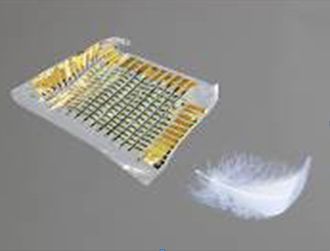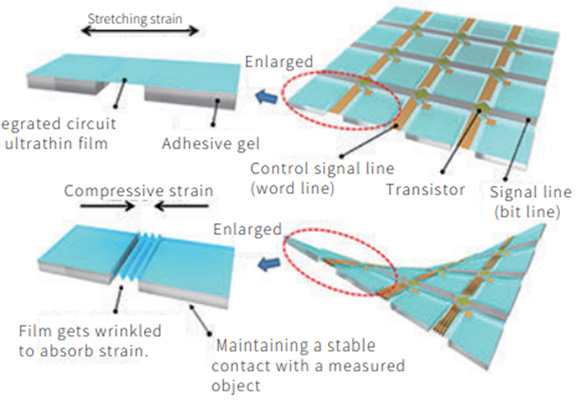Research Results
Thin and soft
Organic devices in harmony with humansFY2019
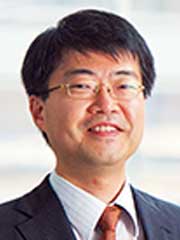
- Takao Someya (Professor, Department of Electrical Engineering and Information Systems, Graduate School of Engineering, The University of Tokyo)
- CREST
- Large-area nanosystem interface applications “Creation of Nanosystems with Novel Functions through Process Integration” Research Representative (2009-2012)
- ERATO
- “Someya Bio-Harmonized Electronics Project” Research Director (2011-2017)
- SICORP
- “Continuous health status monitoring of elderly people using flexible skin patch sensors” Project Leader in Japan (2016-2018)
- ACCEL
- “Conformal Bioimager” Research Director (2017-2021)
Soft electronics that harmonizes with the living body
The fields of telecommunications and electronics have made remarkable progress, and health management using electronic devices such as wearable devices with portable sensors and smartphones are rapidly spreading. Under such circumstances, there is more and more expectations on technologies that read and use various information emitted from living bodies.
Most previous electronics are made of inorganic hard materials, not well fitting with soft living bodies, and their application to fields of medicine and biology is limited. In recent years, instead of inorganic materials represented by silicon, increasing attention is placed to organic materials with high compatibility to living bodies that are inexpensive, light, soft, and can be used in the field of healthcare.
Professor Takao Someya first focused on the development of organic devices to harmonize with humans, and accumulated research on materials and componentization. Biological tissues such as human cells often have inflammatory reactions when they come in contact with hard materials. Therefore, Professor Someya focused on molecular nanomaterials such as molecules of organic semiconductors that are soft and more human-friendly. He is a front-runner in the new field called “stretchable electronics”. By fully utilizing nanotechnology and the previous unique device technology, various electronic devices have been created, which can be bent, stretched, and twisted. In his CREST project, his team developed a technology to build a sheet-type sensor with large surface area and flexibility using an organic transistor. Meanwhile, his ERATO project established a technology to create a high-performance organic transistor integrated circuit on an extremely thin polymer substrate with a thickness of 1 micrometer. He developed a sheet sensor that would not break if rolled up tightly, and could be adhered to a curved surface such as human skin.
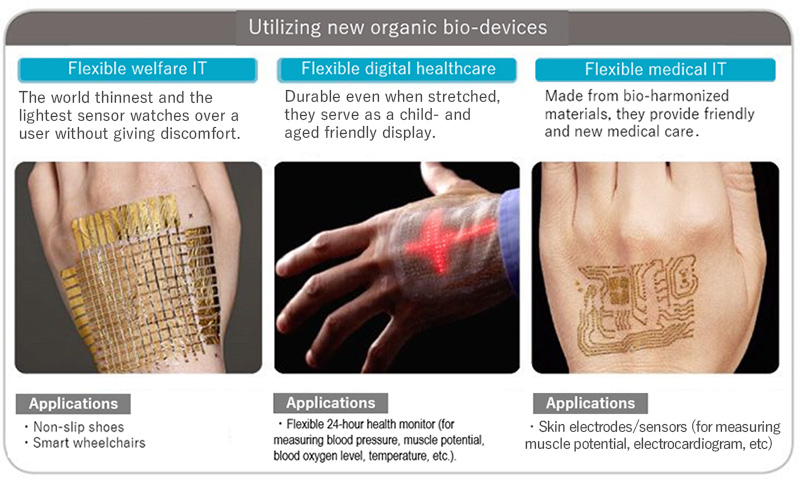
Reading bio-signals with organic devices
Professor Someya and his team attempted to develop a device that conforms the movement of the body surface, and reads the vital signs. If adherence to living tissues increase, minute electrical signals from various parts of the body can be measured with very little noise. This technology can be widely used; for example, from health monitoring sensors, to implantable devices, and from wearable to implantable sensors.
“Organic devices” developed by Someya's team can be easily be printed on flexible polymer films. By utilizing the unique functions of organic materials, it is possible to develop a new device that harmonizes and merges with the living organism by a simple method. However, these devices cannot be applied to medical treatment as they are. Bio-probes are currently being developed with organic materials that are more compatible with human body.
Development of world's lightest and thinnest soft electronic circuit
In 2013, Professor Someya and his group developed the world's thinnest (2 µm), lightest (3 g/m2), and soft electronic circuits. The high-performance organic transistor IC built on a 1.2 µm polymer film has a thickness of 2 µm, which is about 1/5 of plastic kitchen wrap, and has a weight lighter than a feather. As far as the robustness is concerned, they are amazingly tough in spite of being the world's thinnest. Indeed, the ICs are mechanically and electrically unbreakable, even when squeezed and crumpled like paper.
Someya's team used this technology to realize a sheet-type electronic circuit that can measure biometric data by simply adhering a sheet like a patch. An integrated circuit was built using high-performance organic transistors on a polymer film, and adhesive gel connects electrodes and the living tissues. Sticky surface prevents the device from slipping off. By directly applying to the human skin or to the surface of a rat heart, bioelectrical signals were measured.
Someya's unique technology of fabricating organic transistors on stretchable substrates are developed into various applications; such as ultra-flexible organic LEDs that can be crumpled like a paper, and thin and highly elastic skin displays.
Furthermore, Someya's team developed a new ink that can be printed on textiles in a single step to form highly conductive and stretchable connections. This ink contains fluorine rubber and achieves the world's highest conductivity when stretched more than five times the original length. Using this new ink, the group created a wrist-band muscle activity sensor by printing an elastic conductor on a sportswear material, and it measured muscle activity by detecting slim muscle electrical potentials. If various biological information including myopotential could be simultaneously measured anytime, anywhere, it would have even wider wearable applications.
The world's lightest and thinnest soft electronic circuit
There is a sense of expectation surrounding their use in healthcare sensors that will be lighter than feathers and imperceptible to users (Nature; Doi: 10.1038/nature12314).
Skin display—human skin becomes a display just by attaching—
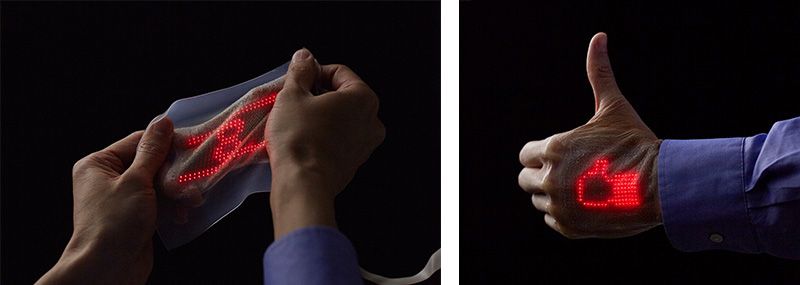
With unique hybrid electro packaging technology, we attached 16×24 micro LED (hard components) and stretchable wires onto an elastomer sheet (soft substrate).
The user-friendly wearable sensors for monitoring vitals could serve as one of the long-awaited solutions to reduce the burden of home healthcare.
(Right: Thumbs-up Icon on Skin Display from a communication partner).
Stretchable wires assisted by spontaneous formation of nanoparticles
The ink exhibited the world's highest conductivity even when it was stretched.
The discovery of the spontaneous formation of silver nanoparticles in rubber that ensures high conductivity has promise for new apparel applications.
(Nature Materials. doi : 10.1038/NMAT4904)
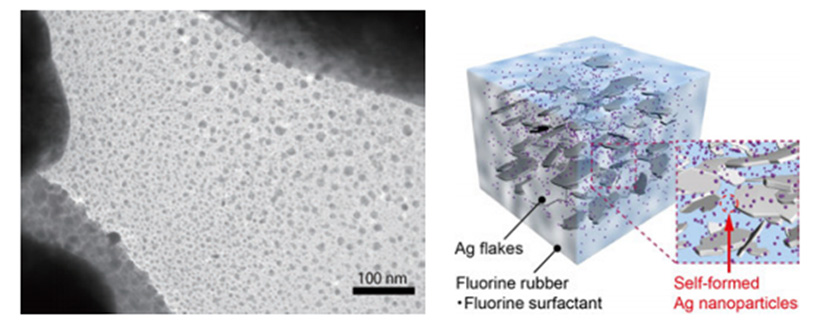
Self-formation of Ag nanoparticles boosts the performance. (Transmission electron microscope (TEM) image)
~8-nm Ag nanoparticles are self-formed in high density.
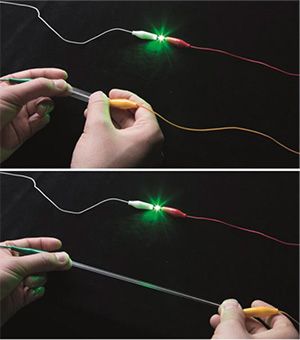
The brightness is unchanged even when stretched five times from the original length. The world's highest conductivity was achieved.
Improving quality of life by biological measurement
Professor Someya and his team aim for an innovation in our day-to- day lives with soft electronics, especially in the field of healthcare, medicine, and welfare. To that end, the project is examining diverse applications. As an application of flexible organic LED in the field of medicine, a sensor that measures the oxygen concentration of blood when laminated on a finger is one of the examples of flexible organic LED's application in the field of medicine. with the device is a combination of an organic photodetector (OPDs) and an organic LED.
A hypoallergenic electronic sensor can be worn on the skin continuously for a week without discomfort was developed as well. The device is constructed from nanoscale meshes containing a water-soluble polymer, polyvinyl alcohol (PVA), and a gold layer. It can be applied by spraying a tiny amount of water, which dissolves the PVA nanofibers and allows it to stick easily to the skin—it conformed seamlessly to curvilinear surfaces of human skin, such as the ridges of an index finger's fingerprint pattern, and measures precisely vital electrical signals. The fine nano-mesh structure does not clog sweat glands, allowing for skin to breath; thus, that users forget they even have it on. If such technology could be applied, groundbreaking devices could be developed in a wide range of fields such as healthcare sensors without discomfort, input devices for stress-free welfare, sensors for electronic medical devices, and robust sensors for athletes. As an example of medical application, an electrocardiography system that combines a nano-mesh sensor, a stretchable silver wire, and a wireless module was successfully developed.
Blood oxygen saturation level/pulse rate sensor
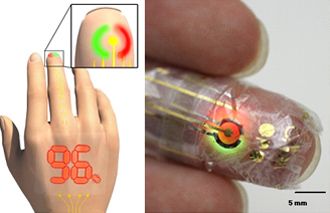
Combination with ultra-flexible organic light-receiving elements makes it possible to create an ultra-flexible blood oxygen concentration/pulse rate sensor that is imperceptible to the wearer.
Nano-mesh electrodes
A breathable nanoscale mesh sensor can be worn on the skin. Since there was no inflammatory response even after patch test on 20 subjects for a week, it holds promise for the development of long-term health monitoring system (Nature Nanotechnology. Doi: 10.1038/NNANO.2017125).
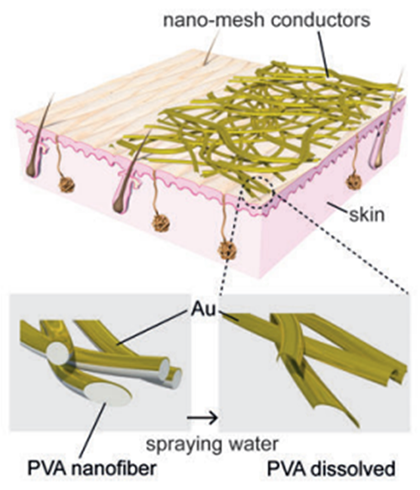
-
A Gold nano-mesh electrode is attached to fingertips.
It conformed seamlessly to the ridges of a fingerprint pattern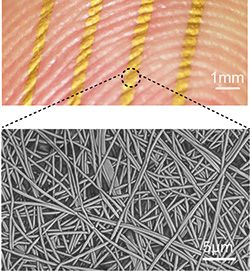
Diameter of 300-500 nm (enlarged)
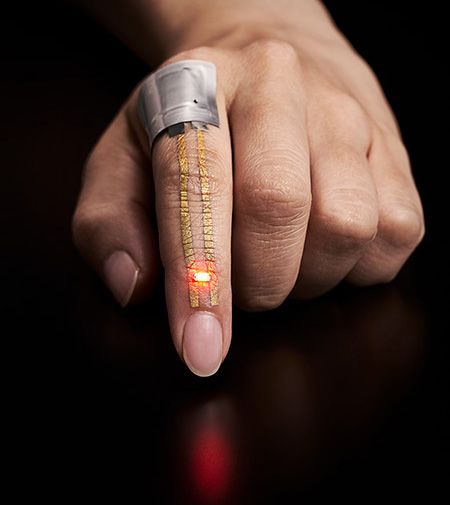
The nano-mesh electrode worn on the skin of an index finger supplies electricity from a flexible battery to illuminate a light-emitting diode.
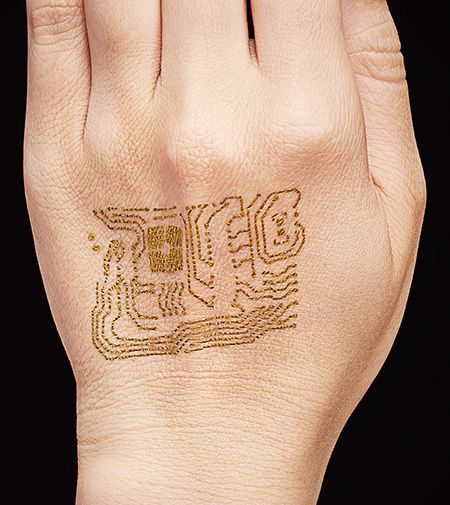
The nano-mesh electrode closely follows the contours for a perfect fit when attached to the skin. The stretchable device lets the skin breathe naturally.
Application for electrocardiography
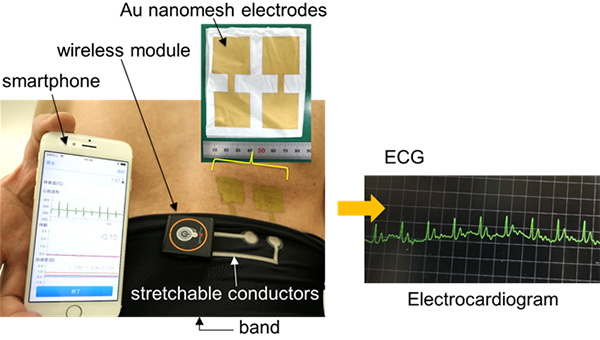
Data measured with the skin sensor are transmitted to a smartphone via a wireless module, and electrocardiogram waveform is monitored in real time on the smartphone screen or on the skin display, or stored in the cloud.
Toward a society where everyone can easily monitor biological information and maintain a healthy body
As Japan faces aging population and decline in birthrate, improvement in quality of life of people, and reduction in medical costs, are urgent issues. If Someya's bio-organic devices are to be integrated with the cutting-edge information infrastructure and novel electronics technology, it holds promise for solving issues of aging population and decline in birthrate from healthcare and medical point of view.
Professor Someya has integrated and developed technologies obtained through former projects; CREST and ERATO, and is now developing a sheet type Conformal Bioimager (flexible image sensor) that allows everyone to easily measure various biological information by attaching on to the skin in the ACCEL project. By developing an on-skin wearable sensor system that monitor people's vital signs without causing any stress or discomfort for 24 hours, he aims to achieve a safe, secure, and comfortable society where people's lives are supported from health management and disease prevention viewpoint.
With this technology, anyone can easily and accurately monitor biological information anytime and anywhere to protect his/her own health. Such day is approaching.
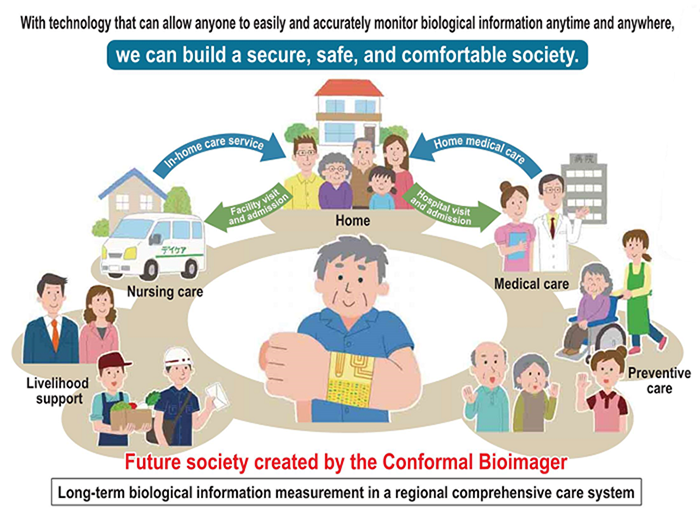
- Life Science
- Research Results
- Japanese

